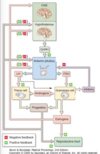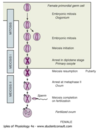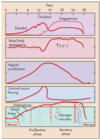female reproductive physiology Flashcards
(73 cards)
diagram the effect in a female with the release of GnRH
- estrogen and progesterone can exert BOTH positive and negative feedback control on: hypothalamus and pituitary
- depends on the hormone production by the growing oocyte during the menstual cycle

what relases LH/FSH and what cells do they effect and how?
- estrogen and progesterone can exert BOTH positive and negative feedback control on: hypothalamus and pituitary
- depends on the hormone production by the growing oocyte during the menstual cycle

LH affects what two cells, describe the relationship.
- estrogen and progesterone can exert BOTH positive and negative feedback control on: hypothalamus and pituitary
- depends on the hormone production by the growing oocyte during the menstual cycle
- LH is not the major

what are the two hormones that exhibit positive and negative feedback. Explain
- estrogen and progesterone can exert BOTH positive and negative feedback control on: hypothalamus and pituitary
- depends on the hormone production by the growing oocyte during the menstual cycle

describe the release of gonadotropin in the anterior pituitary
GnRH-> Gprotein on the anteior pituitary->Gq->PLC
- PLC
- DAG
- PKC
- additive affect
- follicular estrogen has an additive affect
- Activin from the ovary has an additive affect
- inhibitory affect
- luteal phase estrogen and progesterone have an inhibitory affect
- inhibin from the ovary has an inhibitory affect
- additive affect
- gene transcription of LH and FSH
- LH and FSH are synthesized, dimerized and packaged
- PKC
- IP3
- leads to a release of Ca++ from the sarcoplasmic reticulum
- DAG
- Ca++ leads to the exocytosis of the gonadotropin vesicles

what is the affect of the following with respect to the HPA in a female
GnRH-> Gprotein on the anteior pituitary->Gq->PLC
- PLC
- DAG
-
PKC
-
additive affect
- follicular estrogen has an additive affect
- Activin from the ovary has an additive affect
-
inhibitory affect
- luteal phase estrogen and progesterone have an inhibitory affect
- inhibin from the ovary has an inhibitory affect
-
additive affect
- gene transcription of LH and FSH
- LH and FSH are synthesized, dimerized and packaged
-
PKC
- IP3
- leads to a release of Ca++ from the sarcoplasmic reticulum
- DAG
- Ca++ leads to the exocytosis of the gonadotropin vesicles

a patient presents with a tumor generating an incredible amount of progesterone and estrogen. will this be inhibitory or stimulatory of LH and FSH
GnRH-> Gprotein on the anteior pituitary->Gq->PLC
- PLC
- DAG
- PKC
- additive affect
- follicular estrogen has an additive affect
- Activin from the ovary has an additive affect
-
inhibitory affect
- luteal phase estrogen and progesterone have an inhibitory affect
- inhibin from the ovary has an inhibitory affect
- additive affect
- gene transcription of LH and FSH
- LH and FSH are synthesized, dimerized and packaged
- PKC
- IP3
- leads to a release of Ca++ from the sarcoplasmic reticulum
- DAG
- Ca++ leads to the exocytosis of the gonadotropin vesicles

A patient demonstrates a mutation in the IP3 of the cell signaling which of the following is true?
- the patient will have high levels of serum LH and FSH
- The patietn will have high levels intracellular LH and FSH in the anterior pituitary
- the patient will have high levels of estrogen
The patient will have high levels of intracellular LH and FSH in the anterior pituitary. IP3 is needed to send the vesicles filled with LH and FSH out via exocytosis
GnRH-> Gprotein on the anteior pituitary->Gq->PLC
- PLC
- DAG
- PKC
- additive affect
- follicular estrogen has an additive affect
- Activin from the ovary has an additive affect
- inhibitory affect
- luteal phase estrogen and progesterone have an inhibitory affect
- inhibin from the ovary has an inhibitory affect
- additive affect
- gene transcription of LH and FSH
- LH and FSH are synthesized, dimerized and packaged
- PKC
- IP3
- leads to a release of Ca++ from the sarcoplasmic reticulum
- DAG
- Ca++ leads to the exocytosis of the gonadotropin vesicles

where is estrogen synthesized in a female?
Bulk is generated by the granulosa cells
women have two forms of estrogen
- weak - estrone E1
- strong - Estradiol E2

what 18 carbon compound is essential for the female reproductive tract?
women have two forms of estrogen
- weak - estrone E1
- strong - Estradiol E2

describe the synthesis of weak and strong female hormone. Describe the carbon number for each
women have two forms of estrogen
- weak - estrone E1
- strong - Estradiol E2

an increase in cAMP occurs from what cells in response to what hormones?
formation of estrogen
- granulosa cells
- provide a protective/nursing function and express FSH receptors
- induces expression of LH receptors on granulosa cells in late follicular phase.
- Allows granulosa cells to maintain high aromatase function as FSH falls and allows cells to respond to LH surge.
- FSH decreases in response to inhibin
- LACK HYDROXYLASE and DESMOLASE
- means that DHEA and androsteridiol must be generated in the theca and transfered over to the granulosa.
- provide a protective/nursing function and express FSH receptors
- theca cells
- considered nurse cells
- express LH receptors and produce androgens (progesteron +androstenedione)
- LACK THE ENZYME AROMATASE
- means the last product generated is testosterone and andrsteridiol for the granulosa cells (not sure what androsterone is for)
- biochemistry= constant in theca but receptors and function change in granulosa
- LH stimulaes theca cells ->increase cAMP -> increase syntheis of LDL and HDL receptors along with STaR protein
- theca cells increase synthesis of androstenedione
- androstenedione diffuses freely to granulosa cells
- FSH stimulates granulosa cells increasing cAMP leading to an increase in
- aromatase function
- LH receptors
- aromatase converts androstenedione to erstrone
- 17B-HSDehydrogenase converts estone to estradiol
- FSH incduced LH receptor expression on the granulosa cells in late follicular phase->allows
- high aromatase function when FSH falls
- Response to LH surge
- Estradiol diffuses into blood vessels

what enzymes are lacking in the theca and granulosa cells? Explain the dynamic between the two
formation of estrogen
- granulosa cells
- provide a protective/nursing function and express FSH receptors
- induces expression of LH receptors on granulosa cells in late follicular phase.
- Allows granulosa cells to maintain high aromatase function as FSH falls and allows cells to respond to LH surge.
- FSH decreases in response to inhibin
- LACK HYDROXYLASE and DESMOLASE
- means that DHEA and androsteridiol must be generated in the theca and transfered over to the granulosa.
- provide a protective/nursing function and express FSH receptors
- theca cells
- considered nurse cells
- express LH receptors and produce androgens (progesteron +androstenedione)
- LACK THE ENZYME AROMATASE
- means the last product generated is testosterone and andrsteridiol for the granulosa cells (not sure what androsterone is for)
- biochemistry= constant in theca but receptors and function change in granulosa
- LH stimulaes theca cells ->increase cAMP -> increase syntheis of LDL and HDL receptors along with STaR protein
- theca cells increase synthesis of androstenedione
- androstenedione diffuses freely to granulosa cells
- FSH stimulates granulosa cells increasing cAMP leading to an increase in
- aromatase function
- LH receptors
- aromatase converts androstenedione to erstrone
- 17B-HSDehydrogenase converts estone to estradiol
- FSH incduced LH receptor expression on the granulosa cells in late follicular phase->allows
- high aromatase function when FSH falls
- Response to LH surge
- Estradiol diffuses into blood vessels

LH leads to an increase in which receptors and proteins?
formation of estrogen
- granulosa cells
- provide a protective/nursing function and express FSH receptors
- induces expression of LH receptors on granulosa cells in late follicular phase.
- Allows granulosa cells to maintain high aromatase function as FSH falls and allows cells to respond to LH surge.
- FSH decreases in response to inhibin
- LACK HYDROXYLASE and DESMOLASE
- means that DHEA and androsteridiol must be generated in the theca and transfered over to the granulosa.
- provide a protective/nursing function and express FSH receptors
- theca cells
- considered nurse cells
- express LH receptors and produce androgens (progesteron +androstenedione)
- LACK THE ENZYME AROMATASE
- means the last product generated is testosterone and andrsteridiol for the granulosa cells (not sure what androsterone is for)
- biochemistry= constant in theca but receptors and function change in granulosa
- LH stimulaes theca cells ->increase cAMP -> increase syntheis of LDL and HDL receptors along with STaR protein
- theca cells increase synthesis of androstenedione
- androstenedione diffuses freely to granulosa cells
- FSH stimulates granulosa cells increasing cAMP leading to an increase in
- aromatase function
- LH receptors
- aromatase converts androstenedione to erstrone
- 17B-HSDehydrogenase converts estone to estradiol
- FSH incduced LH receptor expression on the granulosa cells in late follicular phase->allows
- high aromatase function when FSH falls
- Response to LH surge
- Estradiol diffuses into blood vessels

What occurs in a patient with a mutant aromatase?
no formation of estrogen and possibly a masculization. no mensing. brittle bones.
- granulosa cells
- provide a protective/nursing function and express FSH receptors
- induces expression of LH receptors on granulosa cells in late follicular phase.
- Allows granulosa cells to maintain high aromatase function as FSH falls and allows cells to respond to LH surge.
- FSH decreases in response to inhibin
- LACK HYDROXYLASE and DESMOLASE
- means that DHEA and androsteridiol must be generated in the theca and transfered over to the granulosa.
- provide a protective/nursing function and express FSH receptors
- theca cells
- considered nurse cells
- express LH receptors and produce androgens (progesteron +androstenedione)
- LACK THE ENZYME AROMATASE
- means the last product generated is testosterone and andrsteridiol for the granulosa cells (not sure what androsterone is for)
- biochemistry= constant in theca but receptors and function change in granulosa
- LH stimulaes theca cells ->increase cAMP -> increase syntheis of LDL and HDL receptors along with STaR protein
- theca cells increase synthesis of androstenedione
- androstenedione diffuses freely to granulosa cells
- FSH stimulates granulosa cells increasing cAMP leading to an increase in
- aromatase function
- LH receptors
- aromatase converts androstenedione to erstrone
- 17B-HSDehydrogenase converts estone to estradiol
-
FSH incduced LH receptor expression on the granulosa cells in late follicular phase->allows
- high aromatase function when FSH falls
- Response to LH surge
- Estradiol diffuses into blood vessels

what are five functions of the ovarian follicle?
The ovarian follicle is the functional unit of the ovary
- ovarian follicle=one germ cell completely surround by a cluster of endocrine cells
- function
- maintains and nurtures the oocyte
- matures the oocyte and releases it at the approtpriate time
- prepares the vagina and fallopian tubes to assist in fertilization
- prepares the uterus to accept and implant a zygote
- maintains hormonal support of the fetus until placenta takes over
one germ cell completely surround by a cluster of endocrine cells
The ovarian follicle is the functional unit of the ovary
- ovarian follicle=one germ cell completely surround by a cluster of endocrine cells
- function
- maintains and nurtures the oocyte
- matures the oocyte and releases it at the approtpriate time
- prepares the vagina and fallopian tubes to assist in fertilization
- prepares the uterus to accept and implant a zygote
- maintains hormonal support of the fetus until placenta takes over
the functional unit of the ovary
The ovarian follicle is the functional unit of the ovary
- ovarian follicle=one germ cell completely surround by a cluster of endocrine cells
- function
- maintains and nurtures the oocyte
- matures the oocyte and releases it at the approtpriate time
- prepares the vagina and fallopian tubes to assist in fertilization
- prepares the uterus to accept and implant a zygote
- maintains hormonal support of the fetus until placenta takes over
function of the ovarian follicle include
- maintain and nurture
- matures ___ and releases it
- prepares the ____ and ____ to assist in fertilization
- prepares the ___ to thicken
- assists fetus until the ____ takes over
The ovarian follicle is the functional unit of the ovary
- ovarian follicle=one germ cell completely surround by a cluster of endocrine cells
- function
- maintains and nurtures the oocyte
- matures the oocyte and releases it at the approtpriate time
- prepares the vagina and fallopian tubes to assist in fertilization
- prepares the uterus to accept and implant a zygote
- maintains hormonal support of the fetus until placenta takes over
Describe what occurs during the follwing dates
- gestaion
- week 5-6
- month2-6
- after puberty
- day 28 of cycle
- gestation
- week 5-6
- primordial germ cells divide mitotically
- by week20-24 = 7million
- primordial germ cells divide mitotically
- 2month-6month gestation
- oogonia enter prophase of meiosis 1 and become primary oocytes and remain in prophase until sexual maturity
- primary oocytes + layer of granulosa cells = primordial follicle
- basil lamina is formed on the outside of the granulosa cells
- week 5-6
- after puberty
- formation of secondary follicle from primary follicle is characterized via
- addition of thecal layer of cells
- post pubertal follicular development is under the control of cyclic FSH release
- day 28 of cycle = graafian follicle development
- occurs 70-85 days post menarche(first menstrual cycle)
- vesicles of the secondary follicle coalesce forming an antrum rich in estrogen
- estrogen is due to theca and granulosa cells in the cumulusoophorus
- graafian follicle increases in size
- theca cells strech and blister in a bulge formation
- formation of secondary follicle from primary follicle is characterized via
post pubertal follicular development is under the control of cyclic ___ release
- gestation
- week 5-6
- primordial germ cells divide mitotically
- by week20-24 = 7million
- primordial germ cells divide mitotically
- week 2month-6month gestation
- oogonia enter prophase of meiosis 1 and become primary oocytes and remain in prophase until sexual maturity
- primary oocytes + layer of granulosa cells = primordial follicle
- basil lamina is formed on the outside of the granulosa cells
- week 5-6
- after puberty
- formation of secondary follicle from primary follicle is characterized via
- addition of thecal layer of cells
- post pubertal follicular development is under the control of cyclic FSH release
- day 28 of cycle = graafian follicle development
- occurs 70-85 days post menarche(first menstrual cycle)
- vesicles of the secondary follicle coalesce forming an antrum rich in estrogen
- estrogen is due to theca and granulosa cells in the cumulusoophorus
- graafian follicle increases in size
- theca cells strech and blister in a bulge formation
- formation of secondary follicle from primary follicle is characterized via
describe the flow of maturation in oogenesis
- primordial germ
- oogonia
- primary oocytes
- primordial follicle
- primary follicle
- secondary follicle
- graafian follicle
- gestation
- week 5-6
- primordial germ cells divide mitotically
- by week20-24 = 7million
- primordial germ cells divide mitotically
- week 2month-6month gestation
- oogonia enter prophase of meiosis 1 and become primary oocytes and remain in prophase until sexual maturity
- primary oocytes + layer of granulosa cells = primordial follicle
- basil lamina is formed on the outside of the granulosa cells
- week 5-6
- after puberty
- formation of secondary follicle from primary follicle is characterized via
- addition of thecal layer of cells
- post pubertal follicular development is under the control of cyclic FSH release
- day 28 of cycle = graafian follicle development
- occurs 70-85 days post menarche(first menstrual cycle)
- vesicles of the secondary follicle coalesce forming an antrum rich in estrogen
- estrogen is due to theca and granulosa cells in the cumulusoophorus
- graafian follicle increases in size
- theca cells strech and blister in a bulge formation
- formation of secondary follicle from primary follicle is characterized via
what occurs 3-4 months after menarche?
- gestation
- week 5-6
- primordial germ cells divide mitotically
- by week20-24 = 7million
- primordial germ cells divide mitotically
- week 2month-6month gestation
- oogonia enter prophase of meiosis 1 and become primary oocytes and remain in prophase until sexual maturity
- primary oocytes + layer of granulosa cells = primordial follicle
- basil lamina is formed on the outside of the granulosa cells
- week 5-6
- after puberty
- formation of secondary follicle from primary follicle is characterized via
- addition of thecal layer of cells
- post pubertal follicular development is under the control of cyclic FSH release
-
day 28 of cycle = graafian follicle development
- occurs 70-85 days post menarche(first menstrual cycle)
- vesicles of the secondary follicle coalesce forming an antrum rich in estrogen
- estrogen is due to theca and granulosa cells in the cumulusoophorus
- graafian follicle increases in size
- theca cells strech and blister in a bulge formation
- formation of secondary follicle from primary follicle is characterized via
describe the phases that the oocyte is arrested in and why
- oogonium
- meiosis begins
- Integral proteins are low in concentration so the oocyte “arrests” in prophase 1 for up to 50 years
- primary oocyte
- as oocyte grows it synthesizes proteins required to complete meiosis, but high cAMP levels actively maintain arrested state
- just prior to ovulation
- oocyte completes meiorsis 1 and extrudes 1st polar body
- arresting in metaphase 2
- secondary oocyte
- completes meiosis at fertilization and extrudes second polar body








































